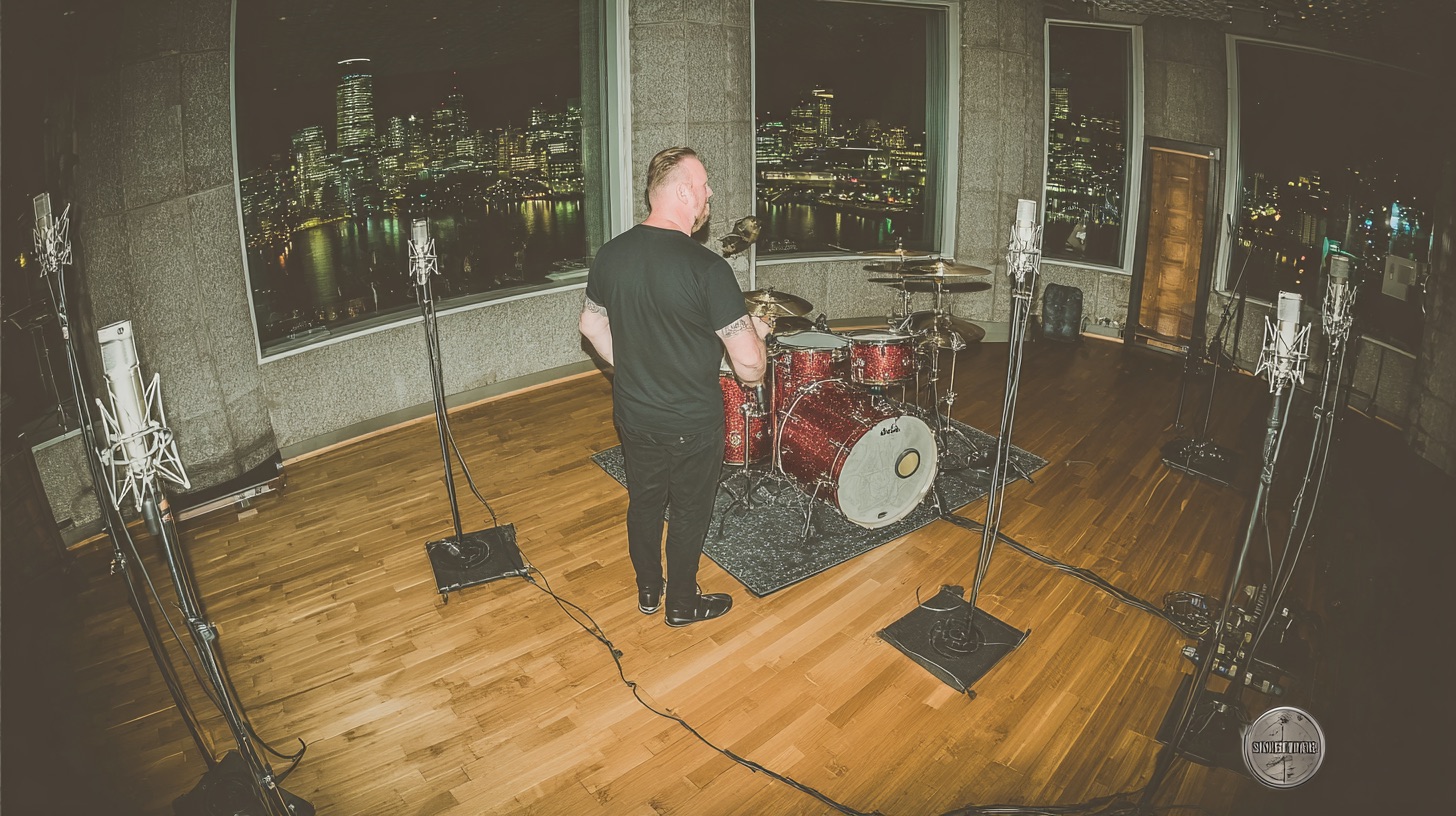
Mixing Modern Metal: The Ultimate Guide To Finding Your Sound
Nail The Mix Staff
The modern metal soundscape is a beast. We’re talking about earth-shattering low tunings, arrangements denser than a black hole, vocals that could strip paint, and an audience that expects nothing less than sonic perfection. In this environment, it’s incredibly easy to fall into the “preset trap,” churning out mixes that sound… well, like everyone else’s. But what if you could forge a sound that’s undeniably yours? A signature that makes your mixes stand out?
That’s what this is all about. Forget just slapping on the latest hyped plugin or copying settings you saw on a forum. We’re diving deep into how you can develop your unique sonic identity by understanding core principles, fearlessly experimenting, and truly learning from the best – not just mimicking them. Modern metal doesn’t just ask for a good mix; it demands a statement. Let’s figure out how to make yours.
Deconstructing Pro Mixes: More Than Just Plugin Peeking
We’ve all been there. You hear an absolutely crushing mix, find out what plugins the engineer used, and try to replicate it. Nine times out of ten, it falls flat. Why? Because that “perfect” sound wasn’t just about the settings; it was a snapshot that worked for a specific player, a particular down-tuned riff, that specific drum performance, in that unique song, serving an overall artistic vision. With tools like amp profilers, for instance, you’re often capturing a specific moment in time that worked in one context – not necessarily a universally applicable sound. That killer tone on your favorite record worked because of a million tiny contextual factors, not just the gear itself.
So, instead of just screenshotting plugin GUIs, start listening with intent. Ask yourself why a producer made a certain choice.
- Was the goal of that aggressive snare to cut through a wall of Drop F guitars?
- How is that monstrous guitar tone serving the riff’s emotion and the song’s overall vibe?
- What was the effect they were trying to achieve – punch, width, depth, clarity on a specific element?
Use reference tracks as study guides, not as IKEA instructions. Analyze how different elements interact in a dense modern metal mix. How does the bass maintain definition against those 8-string guitars? How do the vocals stay intelligible during a 280 BPM blast beat? Focus on the role of each sound. Pick a section of a pro metal mix you admire. Try to mentally solo instruments. What’s its primary job here? What frequencies seem to dominate its space? How dynamic is it compared to other elements? This active listening is the first step to internalizing the principles at play.
Master Your Arsenal: Truly Learning Your Tools
Presets are awesome. They’re fantastic launchpads for understanding what a plugin can do, for quickly sketching out a vibe, or when you’re under a crushing deadline. But they are not the final destination if you’re aiming for a signature sound. The real magic happens when you move beyond the stock setting and start sculpting.
Understanding “The Why” – Character & Application:
- Compressors: They do more than just “make it louder” or control dynamics. Different compressor types (FET, Opto, VCA, Vari-Mu) have distinct sonic footprints and behave differently. How do the attack and release settings shape the punch of a kick drum versus the aggression of a rhythm guitar? For modern metal, understanding how to use compression to add smack, sustain, and control to brutally fast transients is crucial.
- Try This: Slap a Slate Digital FG-Stress (Distressor emulation) on a gnarly metal bass track and then switch to something like an LA-2A style optical compressor plugin. Crank them until you hear them working. The difference in how they grab, hold, and release the signal will be night and day.
- EQs: An EQ isn’t just for fixing problems; it’s a powerful tonal shaper. Different EQ designs (parametric, graphic, passive-style emulations like Pultecs) impart their own color. Modern metal mixing, with its inherent frequency battles from super-low tunings and dense layers, often requires an “EQ master” approach. Carving space vs. broad tonal shaping is a key skill.
- Try This: Tackle a muddy, low-tuned guitar riff. First, try cleaning it up with a precise digital EQ like FabFilter Pro-Q 3, making sharp, targeted cuts. Then, try achieving a similar result with a Pultec emulation, using its broader, more musical curves. The end result might be similar in terms of clarity, but the feel and character will differ.
- Microphones & Amps – The Source is Sacred: Your mix can only be as good as what you record. Understanding the inherent sound of your mics is fundamental. That Shure SM7B on vocals or SM57 on a guitar cab? Its famous mid-range presence will interact drastically differently with various preamps or sources. Similarly, preamp choice matters. An API-style preamp will give you a punchy, aggressive character, quite different from the cleaner preamps on an interface like a Universal Audio Apollo, or the sought-after warmth of a Neve. Using quality preamps (including good quality, inexpensive recreations from companies like Warm Audio) can be a significant step up for capturing impactful sounds. It’s all about the chain: Guitar -> Pedals -> Amp -> Cab -> Mic -> Preamp. Each piece interacts with the others. Changing one element can change the entire sonic equation. Understanding the characteristics of the mic versus the amp is crucial.
Actionable Tip: The “One Plugin Challenge”
Pick one specific plugin type – say, an 1176-style FET compressor. For an entire week, use only that compressor (or its various emulations) on every track that needs compression. Drums, bass, guitars, vocals – everything. Push it, abuse it, learn its sweet spots, its ugly spots, and its unique character. The following week, pick a different type. This deep dive is invaluable.
Sessions to check out:
Creative Automation: Making Your Mix Breathe and Morph
In the relentless assault of modern metal, automation is your secret weapon for creating mixes that are not just loud, but also dynamic, engaging, and clear. It’s about so much more than just riding the vocal fader.
Beyond Volume Faders:
- Dynamic EQ Automation: This is HUGE for modern metal. Need to make space for a guttural vocal in a super-dense chorus? Automate a slight dip in the competing guitar frequencies, but only for that section. Then bring it right back. This keeps the guitars powerful when the vocals are out, and the vocals clear when they’re in.
- Effects Automation – Adding Life and Emphasis:
- Reverb/Delay Throws: Automate a send to a big reverb or a wild delay on the last word of a vocal line, or on a specific snare hit before a transition. Let it bloom, then duck it out.
- Saturation/Distortion: Want a riff to hit harder in the second half of a verse? Automate a saturation plugin to kick in, adding harmonics and aggression, then pull it back for the pre-chorus.
- Stereo Width: Make your choruses absolutely explode by automating a stereo widener on the guitars or synths. Conversely, narrow down elements in verses or bridges for focus and impact when the width returns.
- Panning Automation – Creating Movement and Space: Don’t let your elements sit static. Subtle (or not-so-subtle) panning automation on layered guitars, backing vocals, or atmospheric synths can create a huge sense of movement and prevent your mix from sounding flat and congested.
Actionable Tip:
Grab a dense, busy chorus section from one of your modern metal mixes. Pick an element that feels a bit buried or is fighting for space, like a lead vocal or a guitar solo. Instead of just cranking its fader (which might mess up your overall balance), try automating a high-mid EQ boost on it only during its key moments. Or, automate its pan position very subtly from left to right over the course of the section to give it a subliminal sense of movement and its own unique spot.
Arrangement as a Mixing Tool: Solving Problems at the Source
Often, the gnarliest mixing problems aren’t actually mixing problems – they’re arrangement problems. Before you spend hours battling frequencies, take a step back and look at the song itself. A great arrangement can practically mix itself; a cluttered one will fight you every step of the way. In metal, the way a track sounds, feels, and hits is intrinsically linked to its arrangement – it’s a core part of the song’s DNA.
- Strategic Subtraction & Simplification – The Mute Button is Your Friend:
- Sometimes, the best EQ move is the mute button. If two guitar parts are clashing, does one really need to be there? Could a complex harmony be simplified to create more space and impact?
- Ask yourself: Does this part truly serve the song, or is it just there because it can be? In ultra-dense modern metal, every element needs to justify its existence.
- Orchestration & Layering – Impact Through Variation, Not Just Volume:
- Octaves & Harmonies: Think about how a riff or melody is presented. A single note has a different weight and occupies a different sonic space than that same note doubled an octave up or down, or harmonized with a third or a fifth. Experimenting with different ways to present and layer octaves is valuable because each approach yields a dramatically different feel and impact within the mix.
- Synth/Orchestral Layers: These are powerful tools in modern metal, but they must support, not suffocate, the core instruments. Ensure they have their own frequency space and rhythmic purpose. Often, these elements are best written with the primary metal arrangement in mind, rather than being tacked on as an afterthought. When you hear intricate orchestrations in a band like Doth, for example, those layers are considered integral from an early stage of the composition.
Actionable Tip:
Isolate a section of one of your mixes that feels muddy, congested, or just plain undefined. Before you instinctively reach for an EQ or compressor, try muting one instrument at a time. Does the mix suddenly breathe and open up? If so, could that muted part be simplified? Perhaps played in a different octave to move it out of the way of another crucial element? Or could its rhythm be slightly altered to create a better groove and less direct competition? Sometimes an arrangement tweak is far more effective than any amount of plugin processing.
Embracing “Happy Accidents”: The Unpredictable Path to Uniqueness
The “rules” of mixing are important. They’re built on decades of experience and acoustic principles. But the most exciting, groundbreaking sounds often come from producers who understood those rules well enough to know when and how to break them.
- The Power of “What If…?”:
- Don’t be afraid to try that plugin chain that makes no logical sense. Route that aux send in a way you’ve never considered. What if you put a flanger before your high-gain amp sim? What if you sidechain your reverb to the hi-hats?
- Some of the most iconic and signature sounds in music history (think of certain guitar tones from the 70s or drum sounds from the 80s) were born from engineers pushing gear to its limits or using it in ways its designers never envisioned.
- Learning from What “Doesn’t Work”:
- Every experiment, even one that sounds like a dumpster fire, teaches you something. You learn the limits of your tools, you refine your taste, and you discover what not to do next time. That “failure” is still valuable data.
- Don’t be afraid to make things sound “bad” in a controlled environment. It’s in those moments of sonic chaos that you often stumble upon something truly fresh and unexpected.
Actionable Tip: The “Sandbox Session”
Dedicate an hour of your studio time to pure, unadulterated experimentation with a single track from one of your songs (a snare drum is often a great candidate for this). Try every insane idea you can conjure up – run it through a guitar amp plugin, try compressing it before gating it, send it to three different reverbs panned wildly. Don’t aim for “good” in the conventional sense; aim for “different” or even “broken.” You might just discover a technique or a sound that becomes a cornerstone of your signature style.
Developing Your Sonic Fingerprint: The Ongoing Journey
Forging a signature sound isn’t a one-time event; it’s a continuous evolution. It’s about the sum of your influences, your experiments, your successes, and your “failures.”
- Cultivating Your Taste – Listen Actively and Broadly:
- Your sonic fingerprint is heavily influenced by your musical taste. Listen widely – not just to modern metal, but to every genre imaginable. What sounds excite you? What production choices make you lean in? Why? The broader your palette, the more unique your own creations can become.
- The Power of Repetition and Feedback – Mix, Mix, Mix!
- There’s no substitute for mileage. Mix constantly. Finish tracks, even if you don’t think they’re perfect. Each completed mix is a lesson learned.
- Seek out feedback from trusted ears – fellow producers, musicians whose opinions you respect. A fresh perspective can be invaluable in identifying your strengths and areas for growth.
- It’s a Marathon, Not a Sprint:
- Developing a truly unique and compelling sound takes time, patience, and persistent effort. Getting genuinely good at this craft can take years, even a decade. Embrace the journey, enjoy the process of discovery, and trust that your unique voice will emerge.
Sessions to check out:
Conclusion: Your Sound is Waiting to Be Forged
Moving beyond presets is about transforming from a technician who applies settings into an artist who sculpts sound with intention and creativity. It’s about understanding the fundamental principles of audio, deeply learning your tools, and then fearlessly experimenting to find what resonates with you.
This is why we created Nail The Mix: it’s not about just downloading presets from pro sessions. It’s about gaining direct insight into the decision-making processes of world-class metal producers as they tackle real-world mixes from legendary bands like Meshuggah, Periphery, Gojira, and countless others.
When you get your hands on their actual raw multitracks and watch them build a professional metal mix from the ground up, explaining their choices, their struggles, and their triumphs every step of the way, you’re learning the critical thinking skills and advanced techniques that empower you to experiment intelligently and develop your own signature sound. Plus, with access to an exclusive community of thousands of fellow metal producers and a library of exclusive, pro-quality plugins, you get a supportive environment to share your work, get constructive feedback, and truly hone your craft.
Ready to stop chasing presets and start forging your own legendary modern metal mixes? Check out what Nail The Mix has to offer.
Now, go pick one concept from this article and apply it to your very next mix. The sonic battlefield of modern metal awaits your signature. Start building it today.
Get a new set of multi-tracks every month from a world-class artist, a livestream with the producer who mixed it, 100+ tutorials, our exclusive plugins and more
Get Started for $1





